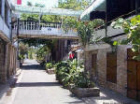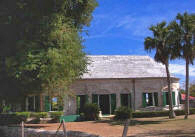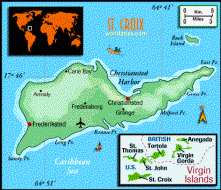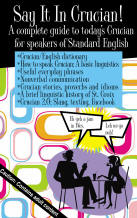|
|
St. Croix
History and General Information







St.
Croix is part of the U.S. Virgin Islands. The territory
is considered
an unincorporated U.S. territory. St. Croix is by far the largest of the
4 U.S. Virgin Islands
(St. Thomas, Water Island and St. John are the other
three). At 84 square miles, St. Croix is about three times the size of St.
Thomas, however, it has about the same population as St. Thomas.
St. John and Water Island are tiny in comparison. Saint Croix has
flown seven different flags. It has been colonized by Spain,
England, the Holland, France, the Knights of Malta,
Denmark, and the United States.
The Carib were the
last of the Native Indian people to inhabit St. Croix. The
Carib people were originally from the Guiana region of South
America. They were not the first Indians on St. Croix..
The Tainos or Arawaks came before them and the Caribs didn't
arrive on the island until the early 1400's. It was the
Carib that greeted Columbus on his second voyage through
the islands.
The Caribs continued
to inhabit St. Croix for about a decade after Columbus'
visit. During this time they lived with an understanding
of mutual coexistence with the Spanish on Puerto Rico. This
understanding ended when a Spanish adventurer raided St.
Croix for Carib slaves. The Caribs then joined with the
Tainos of Puerto Rico, to fight against the Spanish. As
a result of their uprising, the Caribs were ordered to be
eliminated by the Spanish Crown. With 'legalized' extermination
and military action inevitable, the Caribs permanently
abandoned St. Croix.
Sugarcane quickly became the economic
force on the island many years. The development of the sugar
beet in Europe and abolishment of slavery undermined the
economy of the colony. Slavery was abolished after a successful
insurrection in 1848, but in 1862, St. Croix received a
shipload of East Indians that were indentured on the island
for five years. There was a labor revolt by former slaves
in 1878 when much of
Frederiksted, one of the island's two towns, was burnt
down in a labor revolt now known as the Fireburn. It was
reportedly led by four women known as the "Queens" of the
revolt, and a modern island thoroughfare is named after
"Queen Mary" Thomas.
Christopher
Columbus is credited as the first European to have discovered the
island in 1493. He landed at what is know known as
Salt River, which is on the central north coast. He was
searching for
fresh water but didn't find any because a river, was
just an inlet from the sea that resembled the mouth of a
river. There can be small running streams/rivers in the
rainforest, depending on how much rain there has been,
but nothing navigable. The far eastern part of the
island is a bit more arid than the west end. You will
see a lot of cactus plants, with some growing up to 15' high on the
rolling hills. Even though
the island is only 27 miles long, east to west, the
western end of the island has lush green hills that rise
up much higher than on the east end and even includes
a small rainforest. There are pristine, white
sandy beaches all around the island.
Be sure to watch these videos
about St. Croix - St. Croix
Videos
 There
are two towns on the island, Christiansted and
Frederiksted. Christiansted is on the north shore of the
island, just a little east of center, and has many historic buildings.
Christiansted has some of the best examples of Danish architecture
to be found outside
of Denmark! If you are lucky, you may be on the island for
"Jump
Up", which is held in the streets of Christiansted. This
is a "carnival-like" evening, which takes place about four
times a year. It's an evening filled with steel bands, dancing,
local arts and crafts, local food, and lots of fun!
Frederiksted, which is much smaller than Christiansted, has
lovely "gingerbread" Victorian architecture
and is experiencing a renaissance of sorts, as cruise ships
began calling on the port again in 2008. Just on the edge
of town, you will find
Fort Frederik, which was established in the 1700's, and is
noteworthy because this is
where then Governor General Peter Van Scholten read the proclamation
abolishing slavery on the island in 1848. Today
the fort is the home of a museum. Frederiksted has a beautiful
waterfront that draws cruise ships and visitors from around
the globe. On the third Friday of each month, there is
an evening event called "Sunset
Jazz". Admission is free and families
are welcome. Both Christiansted and Frederiksted have
fun shopping and
delicious places to dine! There
are two towns on the island, Christiansted and
Frederiksted. Christiansted is on the north shore of the
island, just a little east of center, and has many historic buildings.
Christiansted has some of the best examples of Danish architecture
to be found outside
of Denmark! If you are lucky, you may be on the island for
"Jump
Up", which is held in the streets of Christiansted. This
is a "carnival-like" evening, which takes place about four
times a year. It's an evening filled with steel bands, dancing,
local arts and crafts, local food, and lots of fun!
Frederiksted, which is much smaller than Christiansted, has
lovely "gingerbread" Victorian architecture
and is experiencing a renaissance of sorts, as cruise ships
began calling on the port again in 2008. Just on the edge
of town, you will find
Fort Frederik, which was established in the 1700's, and is
noteworthy because this is
where then Governor General Peter Van Scholten read the proclamation
abolishing slavery on the island in 1848. Today
the fort is the home of a museum. Frederiksted has a beautiful
waterfront that draws cruise ships and visitors from around
the globe. On the third Friday of each month, there is
an evening event called "Sunset
Jazz". Admission is free and families
are welcome. Both Christiansted and Frederiksted have
fun shopping and
delicious places to dine!
St.
Croix is about 40 miles south of St. Thomas and
St. John. They are separated by a deep oceanic trench...the
deepest in the Atlantic basin, which drops down to over
10,000 feet! St. Croix has wonderful white
sand beaches with warm, crystal
clear waters and is ringed by a reef system making navigating
the waters around the island reserved for only experienced
sailors. All beaches on the island are open to the public,
however, you still need to respect waterfront property owners
as the "public" part of the beach only extends 15 feet up
the beach from the high tide waterline, after that it's private property.
 Historic
plantations, remnants of a time when slavery and agriculture
were the mainstays of the island's economy, are located
all over the island.
The ruins of dozens of sugar mills are scattered all over
the island, a vivid reminder of the island's past.
As you explore the island, you will notice that the
original plantation's names are still used to define
each small area of the island. St Croix
also has great duty free shopping areas and a variety of
land activities and water sports,
enough to keep visitors very entertained. Among its natural
attributes are natural reserves for plant and animal life
including
Buck
Island Reef National Monument, with an underwater snorkeling
trail, Sandy Point National
Wildlife Refuge, a rainforest, and a
botanical
gardens. The Cruzan Rum factory is based on St. Croix
and
Diageo, the world’s
leading spirits, wine and beer company, completed construction
of a high capacity distillery on the island in 2010. The
new facility produces all the bulk rum used to make
Captain Morgan branded products for the United States.
The distillery has a capacity
to distill up to 20 million proof gallons of Captain Morgan
rum per year! Historic
plantations, remnants of a time when slavery and agriculture
were the mainstays of the island's economy, are located
all over the island.
The ruins of dozens of sugar mills are scattered all over
the island, a vivid reminder of the island's past.
As you explore the island, you will notice that the
original plantation's names are still used to define
each small area of the island. St Croix
also has great duty free shopping areas and a variety of
land activities and water sports,
enough to keep visitors very entertained. Among its natural
attributes are natural reserves for plant and animal life
including
Buck
Island Reef National Monument, with an underwater snorkeling
trail, Sandy Point National
Wildlife Refuge, a rainforest, and a
botanical
gardens. The Cruzan Rum factory is based on St. Croix
and
Diageo, the world’s
leading spirits, wine and beer company, completed construction
of a high capacity distillery on the island in 2010. The
new facility produces all the bulk rum used to make
Captain Morgan branded products for the United States.
The distillery has a capacity
to distill up to 20 million proof gallons of Captain Morgan
rum per year!
Driving
the roads on
St. Croix
Although we are a U.S.
territory, we drive on the left side of the road!
All cars, including rentals, are left hand drive models
that you would find in the States. In order to rent a
car on St. Croix, you have to be
at least 25 years old, have a valid drivers license and
proof of insurance.
Maps of St. Croix and the
U.S. Virgin Islands
Visit our
maps page for maps of St. Croix, the U.S. Virgin
Islands and their location in the Caribbean
Other Facts about St. Croix
Because it is a U.S.
territory, the currency used on St. Croix is the U.S. Dollar. Credit cards
are accepted by most St Croix businesses, however, there
are still quite a few small businesses that only
accept cash. ATM machines can be found at most banks,
and many gas station convenience stores also have ATMs. There is no sales tax
on St. Croix, so combining that with duty free discounts
can get you some pretty good prices on jewelry, watches
and liquor.
 The
most spoken language is English, yet many locals also speak English
with a Caribbean twist. For example, the 'H' is often discarded
in words with a "th" so a word like "thing" will be
pronounced "ting", and "thanks" will
be pronounced "tanks").
Click here to Say it in
Crucian.
Spanish is also widely spoken on the island. The
most spoken language is English, yet many locals also speak English
with a Caribbean twist. For example, the 'H' is often discarded
in words with a "th" so a word like "thing" will be
pronounced "ting", and "thanks" will
be pronounced "tanks").
Click here to Say it in
Crucian.
Spanish is also widely spoken on the island.
St. Croix's climate is subtropical The temperature averages 82*F/28*C
year round. and to helping with The
humidity level is kept comfortable most of the year
because of the pleasant easterly trade winds. The
temperature varies less than 10 degrees between the
summer months and the winter months. Summer highs will
likely be in the the 86-89 degree range with the winter
months having daytime highs of 82-84 degrees. With only 50 inches/1270
millimeters of annual rainfall, which occurs mostly in late spring and
fall, the island gets just enough rain to keep it green
most of the year and offer plenty of sunny days! The island is more
likely to see a hurricane in
September / October than any of the other months during
hurricane season. We only know about one major storm
that has hit St. Croix outside of the month of September.
U.S. Virgin Islands use
Country Code - 1...just like on the mainland U.S.
The Area
Code on St. Croix is 340.
The electrical current and
the style of the wall outlets are 110V / 60Hz, just like those
in the U.S. You won't need to use an adapter if you are
visiting from the U.S.


In the main towns, and at most
hotels, the water is treated and is safe to drink. Most private residences utilize
cisterns to store rain water or have water delivered by
truck during drier months of the year. Unless you know the water is
filtered by UV light,
bottled water is recommended for drinking. More
info.
The time zone on St. Croix is Atlantic Standard Time.
This time zone does not follow daylight saving time so
in the summer months it is the same as East coast time.
In the winter months it is 1 hour ahead of Eastern time
zone.
USVI Public Holidays
- click here
U.S.
Customs Duty Free
Allowances
The USVI has the
most generous
duty free allowance in the entire Caribbean! There are no customs
duties on most merchandise, and there are no local luxury
or sales taxes. U.S. citizens are allowed a
duty-free
shopping quota of $1,600.00. Additionally, an unlimited
number of gift packages, worth $100 or less, may be mailed
to family and friends. Citizens may also bring back up to
five cartons of duty-free cigarettes and five fifths of
US liquor duty-free. An extra fifth can be taken if it is
an U.S. Virgin Islands product such as Cruzan Rum.
Click here for more detailed duty free allowance information
for St. Croix and the US Virgin Islands
U.S. Virgin Islands Accommodations
Tax (Hotel Tax)
The Us
Virgin Islands imposes a 12.5% accommodations tax (Hotel Tax)
to all short term lodgings. If your stay is 90 days or less,
you will be subject to this tax. (12.5% as of January 1, 2012)
Click here for some links to some more helpful St. Croix
information.
|
|